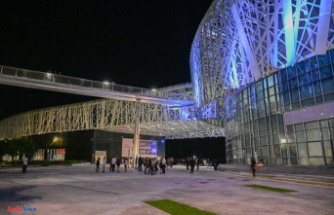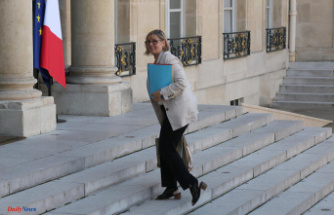Live like God in France? Who among us mortals would want that? We would much rather live like Commissioner Luc Verlain in Aquitaine and feast to our heart's content between vineyards and endless sandy beaches.
Today I start my monthly cookbook review with a riddle: What happens when a crime author and gourmet writes a cookbook? Quite clearly: a criminally delicious read through and through! Such a book is "Chez Luc" by Alexander Oetker. A fairly weighty work, almost 400 pages.
Alexander Oetker is France expert for RTL and ntv, writes for "Feinschmecker" and eats out for ntv.de - and not only in the best restaurants in Germany and Europe: he doesn't even stop at Deutsche Bahn's on-board restaurants! Chapeau! So far I have refrained from such self-experiments. But now I know: If I ever have to take the train, it should be the Czech Eurocity. Because of the beer on tap, the delicious goulash soup - and the punctuality.
So Alexander Oetker has a lot to tell. And how he does it in "Chez Luc" is special: Oetker's protagonist Luc Verlain from the bestseller series of the same name travels with Papa Alain across southwest France, to the Basque country, briefly over to Spain and finally even to Paris. The reason for this road trip by two men is a criminal one: the recipes that the old oyster farmer Alain Verlain had collected over decades were apparently stolen. However, appearances are deceptive, the recipes were only apparently stolen. In any case, Alain and Luc don't just want to give up the culinary treasures, they want to put them together again: "We're just making a new collection of recipes." And so father and son go in search of the best recipes from Bordeaux to Biarritz.
The result is a cookbook of superlatives: it is the first and only one to present the wonderful variety of culinary Aquitaine. The standard work on the cuisine of France's most beautiful region, which is also the workplace of the inspector in the Verlain crime novels, was published by Hoffmann and Campe in October. "I promise you: This is not just a book for the friends and fans of Commissaire Luc Verlain - it is a cookbook, travel guide and declaration of love all in one," writes Alexander Oetker in the foreword.
It is exactly like that. Texts that are easy to read because they are exciting and entertaining, informative without being preachy. Sometimes the author tells the story, sometimes the inspector. Sometimes it's women and men at the stove cooking up stars and making gourmet hearts beat faster, sometimes it's simple bistros and family restaurants that Luc and Alain (and Alexander) visit, feast there and pull the best recipes out of everyone's ribs: " Every chef de cuisine has given us his favorite secret recipes for this book, sometimes the whole menu consists of an entrée, plat et dessert, but sometimes just one very special dish, but they are always specialties that come from the tables and from the tradition between Bordeaux and Biarritz are indispensable."
I would not only like to cook the wonderful dishes, but also drive to where Délia catches the sea bream and taste the cheese at Elorri in the Basque wasteland without mobile phone network and TV. Jump in the car and jet off. Packing your suitcase is overrated, toothbrush and credit card should be enough. Because not only the recipes are seductive, but also the impressive photos of people and animals, landscapes and laid tables. Photos that conjure images in my mind's eye: wanderlust, longing for vacation, travel fever... somehow a bit of everything flows through me while I'm squatting on my couch in autumnal Berlin and leafing through "Chez Luc". As I watch and read, I can hardly resist appetite attacks. Anything French in the freezer or fridge? nope! But there is at least one bottle of French summer rosé, a leftover from warm summer evenings in the garden. Also tastes good in the living room in autumn - the evening is saved!
A little anticipation of my "French evening": Only wine is not enough... and I had an idea - there is always something for "Croque Monsieur"! For "Le Croque Basque" from page 38 there was neither Basque cheese nor ham in the fridge, but my South Tyrolean alternatives did the same. Alexander, Luc and Alain may forgive me: It was still "formidable"!
I didn't count the recipes in "Chez Luc" - there are quite a few. Several registers simplify the search and selection: the recipes are listed according to restaurants and dishes. An index of the ingredients is good for re-cooking at home. "My favorites" list the author's favorite recipes. And then there's a "By Places" tab. There you will find everything from recipes to stories under the respective location; the recipes that are not related to the restaurants are also listed here. Absolutely great for planning a gourmet trip in the footsteps of Luc
It is this "savoir vivre", the art of enjoying life, that we secretly envy the French for. Aquitaine is the epitome of savoir vivre, so Chez Luc and the Verlain mysteries are all about this beautiful area. You can feel Alexander Oetker's love for this region in every line, without glorifying it, without ignoring architectural sins, mass tourism, conflicts and contradictions.
Almost at the same time as the cookbook, Hoffmann and Campe also published "Star Sea", the latest thriller and thus Volume 6 of the bestseller series. Alexander Oetker: "An exciting and enjoyable thriller for everyone who is wondering how things work in a star kitchen and for those who are wondering why geese and ducks are still stuffed for foie gras in France." I wonder about that too.
Which brings me back to "Chez Luc", because the foie gras isn't missing here either. This "cultural asset" is no longer only controversial outside of France. It is and remains force-feeding, even if the "gentle" poultry farmer Marie-Pierre stuffs her animals "very gently" by hand and says in the book: "I love my geese." I actually believe her, and her animals actually have a good and healthy life up to... yes, up to the gavage. Whether stuffed by hand or by machine, which is even more repulsive, the result is a pathologically enlarged organ. A fatty liver in humans calls the doctor to the scene - in geese and ducks the gourmet? And there is something of a double standard when stuffing is banned in Germany, but not the import and sale of foie gras. Especially since more and more cooks, including those with stars, are starting to ponder whether foie gras is still appropriate for ethical reasons, and there is also an alternative that is also humane for the animal: foie gras for which the animals do not have to be stuffed with food.
The range of recipes and ingredients ranges from exclusive like oysters to simple like onions. And so are the dishes - complex or uncomplicated in terms of time and materials. For example "Steaks frites à L'Entrecôte", with which you will be busy for two days. It's hard to believe, but after these steaks you have to queue at the "L' Entrecôte" restaurant in the center of Bordeaux: "Young and old are standing there, the Bordeaux people in their best Sunday best, the Americans in slippers with cameras around their necks." The secret is apparently the sauce: "... the very first bite is the reason why everyone is queuing here: the magic begins. The meat is as tender and fine as a fillet, but the strength comes from the sauce that is poured over the Plenty of meat is waiting on the platter next to it: Gourmets and journalists have been tinkering to decipher the secret of the fameuse sauce since 1959. In vain Toulouse was conceived and is only passed on within the founding family."
But thanks to "Chez Luc", nobody between Sylt and Allgäu, Neisse and Maas has to do without this gourmet steak: In the book you will find "an attempt at a recipe". Mystery or not, "that's how Luc Verlain would prepare it". If he had time to sizzle...
For comparison, an antipole recipe that only takes minutes: "Gilda" from Reise-Kilometer 1734. French? Spanish? It doesn't matter: just Basque. "Gilda" is reminiscent of the film of the same name with Rita Hayworth and is probably the most famous pintxos ever. Before I start the sophisticated entrecôte (my fingers are really itching and the next party will definitely come.), I put the ribbon bookmark in "Gilda": It suits me, even without a (glove) striptease, and all three ingredients available. Voila!
Alexander Oetker visits 25 top chefs from Aquitaine and reveals their favorite menus to us. And not only that: we get to know them and their passions, their producers and why they chose exactly these products. So there are far more people than "just" 25 chefs who told Alexander Oetker about their life and work, which we can now share through the author's written experiences and the wonderful photos of Zuzu Birkhof, Anja Jahn and Markus Bassler .
"For this book, our équipe of crime fiction and cookbook enthusiasts traveled a whopping 7700 kilometers, criss-crossing the Aquitaine. We drove large parts of it in a Jaguar XJ6, exactly the same car that Commissaire Luc Verlain used after a internship at Scotland Yard in London. Unfortunately, our Jaguar had a broken power steering, which made the adventure a little difficult. But it drove fast." Here are some speed camera photos that I found very amusing; the flashed probably not. After all, I don't laugh at my "proof photos" either! This special way of thanking the team forms a harmonious conclusion to this unique road trip. This makes you want to imitate the journey not only with your finger in the book and on the road atlas, but also with the car in real life. If possible without expensive speed camera photos...
"Neither frog legs nor snails, no, the onion soup is the epitome of French cuisine. It simmers for a long time, is full of aroma, warmth and herbs - and then the cheese on top. Once eaten, it becomes nostalgic."
Preparation: Peel the onions (keep the clean skins aside!), halve and cut into thin strips.
Melt the butter in a pan and sauté the onions for about 15 minutes, allowing them to soften and brown.
Scrape the toasted notes from the bottom of the pan, pour in the wine and let it boil down a bit.
Then place the onion base with the onion skins you have set aside and the bouquet garni in a saucepan and pour in enough water to cover the onions well, salt and pepper. Cover and simmer the soup over a low heat for approx. 1.5 hours until the liquid has reduced by about a third.
To serve, preheat the grill. Roast or toast the baguette slices under the grill. Divide the soup between ovenproof bowls or ovenproof deep plates, place two slices of baguette on each and sprinkle with plenty of cheese. Bake under the grill for approx. 8 minutes until golden brown. Take the soup out of the oven and serve it very hot.
"The hake swims long distances, it is correspondingly powerful and very aromatic. Cooked whole on the grill, the Merlu has the advantage that it does not lose the ingredients of the sea - the salt water, the iodine - everything stays in the fish and with it only the full taste is revealed."
Preparation: Preheat the oven to 180°. Cover a baking sheet with parchment paper.
Rinse the hake inside and out and pat dry, then lightly salt and brush with olive oil.
Place the fish on the tray and cook in the oven (middle) for approx. 30 minutes, using 30% humidity if possible.
Meanwhile, sauté the garlic in the sunflower oil in a pan and deglaze with the vinegar.
Remove from the heat and mix in the parsley.
If you like, add 1 very small, diced, aromatic tomato (without stalks and seeds).
Remove the finished fish from the oven and cut in half along the back (you can also cut the fish in half before cooking if you wish).
Sprinkle with the lukewarm garlic mix and Piment d'Espelette and serve immediately.
"The dessert of kings: puff pastry and vanilla cream. After a cassoulet in the fountain, every guest would actually like to answer the dessert question: Non, merci. But then comes the millefeuille - and with the first bite your eyes widen: How can something, that is so beautiful to be so light and airy that the guest doesn't stop until the last crumb has been plastered over."
Preparation: For the crème pâtissière (pastry cream), boil the milk with the split vanilla pod in a saucepan. Remove from stove and set aside. In a mixing bowl, beat the egg yolks with the sugar until light and fluffy. Then add the cornstarch and stir in.
Remove the vanilla bean from the hot milk. Add the hot vanilla milk to the egg mixture one tablespoon at a time while stirring with a whisk. Then pour everything into the pot and let the cream simmer for about 10 minutes while stirring, until a kind of pudding has formed. Then remove from the stove and let cool. Chill the cream and stir frequently to prevent a skin from forming.
Whip the cream until stiff and carefully fold into the crème pâtissière using a spatula. Cut the puff pastry into 18 or 24 rectangles and layer 3 or 4 sheets of cream on top of each other (if you like, apply this with a piping bag with a nozzle) and dust with icing sugar. Serve immediately and chilled to prevent the puff pastry from becoming soggy.
Tip: If you want to make the millefeuille yourself, buy about 400 g of puff pastry from the confectioner. Preheat the oven to 180°C. Line the baking sheet with parchment paper. Roll out the puff pastry to a thickness of about 4 mm, place on the tray and bake in the oven (middle) for 15-20 minutes until crispy. Remove and immediately dust with icing sugar, then let cool, weighted with a wire rack. Cut the puff pastry into 8-12 pieces (approx. 3 x 8 cm) with a serrated knife.
I was, and sometimes still am, always on the lookout for recipes and the stories behind them. Sometimes I took my mother with me on these trips. At that time I thought: too often. Today I think: too rarely. I can't change that anymore. Use your time with parents, children, relatives and friends - "Chez Luc" gives many suggestions for cooking, dining and planning trips together. Heidi Driesner wishes you every success.












